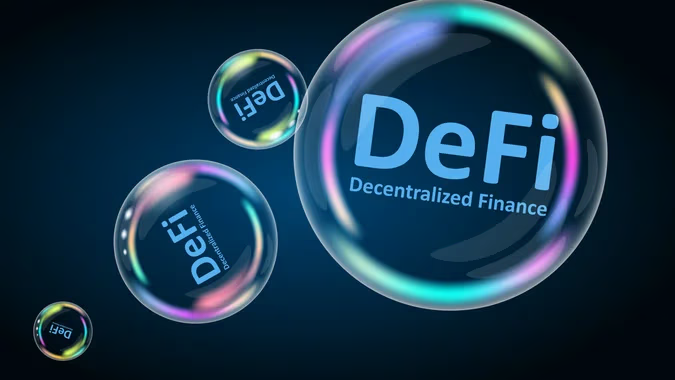Introduction
Imagine a financial world where you can borrow, lend, earn interest, and trade — all without a bank, broker, or middleman. This is the promise of Decentralized Finance (DeFi), one of the fastest-growing sectors in the blockchain ecosystem.
With DeFi, anyone with an internet connection can access financial tools previously reserved for banks and institutions. In this blog, we’ll explore how DeFi works, why it matters, and what opportunities — and risks — it brings to the table.
What is DeFi?
DeFi, short for Decentralized Finance, refers to a suite of blockchain-based financial applications that operate without centralized intermediaries. These apps — called dApps — are built mostly on Ethereum and use smart contracts to execute transactions.
Instead of relying on banks or brokers, users interact directly with protocols to:
- Earn interest
- Borrow and lend assets
- Trade crypto
- Buy insurance
- And more — all without paperwork or approval processes
Core Features of DeFi
| Feature | Traditional Finance | Decentralized Finance |
|---|---|---|
| Access | Limited by geography & status | Global, 24/7, permissionless |
| Control | Centralized (banks, companies) | User-controlled via smart contracts |
| Transparency | Opaque | Fully transparent on the blockchain |
| Interoperability | Fragmented systems | Composable protocols (DeFi “Legos”) |
How Does DeFi Work?
At the heart of DeFi lies the smart contract — self-executing code that runs on a blockchain. These contracts:
- Hold funds in escrow
- Execute trades or transfers based on logic
- Operate autonomously once deployed
Most DeFi applications live on Ethereum, but networks like Solana, Avalanche, Polygon, and Binance Smart Chain are also growing hubs.
DeFi dApps typically include:
- Lending platforms (e.g., Aave, Compound)
- Decentralized exchanges (DEXs) (e.g., Uniswap, SushiSwap)
- Stablecoin protocols (e.g., MakerDAO, Curve)
- Derivatives and synthetic assets (e.g., Synthetix, dYdX)
Real-World Use Cases of DeFi
💸 Lending and Borrowing
Users can deposit crypto to earn passive income (APY), or use it as collateral to borrow other tokens. No banks, no credit checks.
💱 Decentralized Exchanges (DEXs)
Trade tokens directly from your wallet. No registration required. Examples: Uniswap, Balancer, Curve.
🛡️ Insurance
DeFi insurance protocols like Nexus Mutual provide decentralized coverage for smart contract failures and hacks.
🏦 Stablecoins
Pegged to fiat currencies (e.g., USDC, DAI), these tokens maintain stability and are essential for DeFi liquidity.
Yield Opportunities in DeFi
DeFi opens up numerous ways to earn yield:
- Interest from lending protocols like Compound
- Liquidity mining rewards from platforms like PancakeSwap
- Governance tokens for participating in DAO votes
- Staking assets to secure protocols and earn returns
Warning: High yields often come with high risks. Always research the platform before depositing funds.
Benefits of DeFi
- Global Accessibility: All you need is a smartphone and internet.
- Programmable Finance: Automate everything from payroll to insurance payouts.
- Non-Custodial: You keep full control of your assets at all times.
- Innovation at Speed: DeFi protocols evolve quickly, with frequent upgrades and new features.
Risks and Challenges
Despite its potential, DeFi comes with caveats:
- Smart Contract Bugs: Code vulnerabilities can be exploited.
- Rug Pulls: Projects can drain liquidity and vanish.
- Regulatory Risks: Unclear legal status in many countries.
- Price Volatility: Collateralized loans risk liquidation in market downturns.
How to Get Started with DeFi
- Set up a Wallet – Use MetaMask or Trust Wallet
- Buy Crypto – Use exchanges like Coinbase or Binance
- Transfer to Wallet – Send funds to your non-custodial wallet
- Choose a dApp – Visit DeFi platforms (e.g., Aave, Uniswap)
- Connect and Explore – Interact using your wallet (no sign-up required)
Key DeFi Platforms
| Platform | Function | Highlights |
|---|---|---|
| Aave | Lending/Borrowing | Flash loans, variable/stable rates |
| Uniswap | Decentralized Swap | Most popular Ethereum DEX |
| Compound | Lending/Borrowing | Algorithmic interest rates |
| MakerDAO | Stablecoin (DAI) | Decentralized overcollateralization |
| Yearn.Finance | Yield Aggregator | Auto-optimizes DeFi strategies |
Final Thoughts
DeFi represents a shift from centralized power structures to open, inclusive financial systems. It’s not just a trend — it’s a technological revolution. However, with great opportunity comes great responsibility. Understanding the risks and doing your due diligence is key to navigating this emerging space safely.
